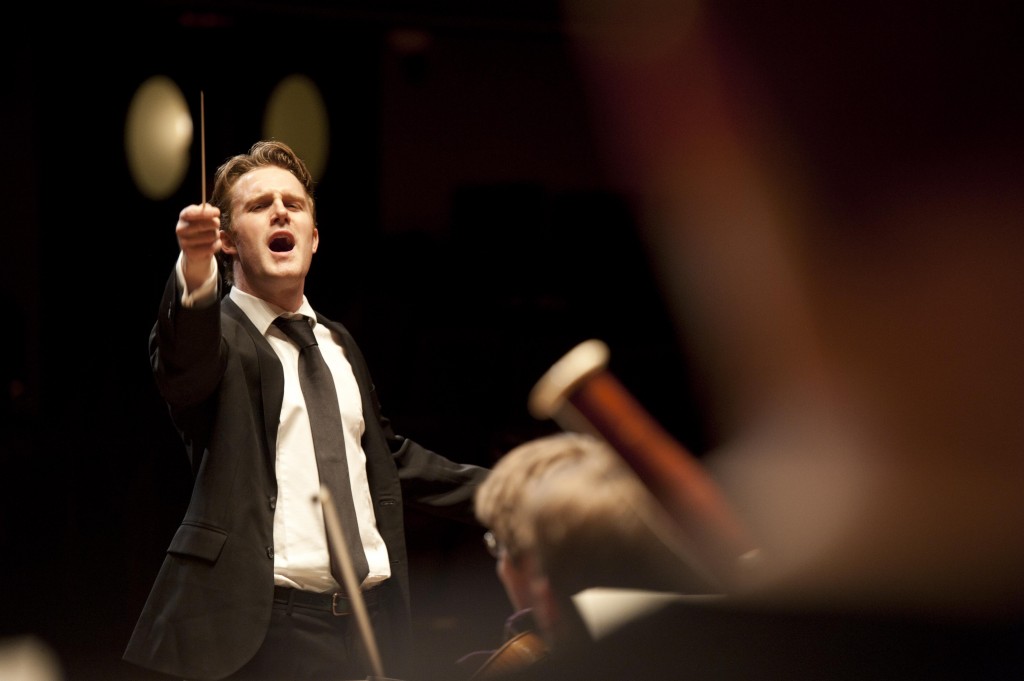Fuse Concert Review: Joshua Weilerstein and the Discovery Ensemble/Courtney Lewis
It’s a pity we can’t hear the Discovery Ensemble every week—it’s a group that radiates energy and models inventive programming.
Joshua Weilerstein and the Discovery Ensemble/Courtney Lewis. At Jordan Hall, NEC, Boston, MA, October 21.
By Jonathan Blumhofer.

Violinist Joshua Weillerstein — he dispatched his part with great dramatic flair and lots of character. Photo: Tony Rinaldo
The Discovery Ensemble opened its fifth season on Sunday afternoon at Jordan Hall. Violinist Joshua Weilerstein joined the Ensemble and conductor Courtney Lewis for a program that juxtaposed somewhat unfamiliar music by Mozart and Bach with works by two leading, twentieth-century, South American composers, Astor Piazzolla and Heitor Villa-Lobos.
Mozart’s Symphony no. 28 is among his less well known only because the several symphonies he wrote surrounding it (nos. 25, 29, 35–41) are among the finest orchestral compositions of the eighteenth century. For any other composer, this would have been a Top-10 hit. Or so it seemed to me based on Sunday’s effervescent performance.
The outer movements were given brisk readings, but they never felt rushed, and Mr. Lewis’s balletic conducting drew billowing waves of dynamic contrasts that emphasized the Sturm und Drang character of the period. The slow movement featured some beautiful, lyrical playing from the ensemble, while the third movement Minuet traipsed along at a courtly gait.
My only complaint about the performance was that the violins were not seated antiphonally: there are many passages, in the first and fourth movements especially, in which Mozart wrote conversationally between the sections, and the stereophonic nature of his counterpoint would have been dramatically enhanced by simply reseating the sections. That the violins were seated across from one another in the closing Bach Suite and not the Mozart was further mystifying.
Oh, well.
After the restraint of the Mozart came a hot-blooded performance of Astor Piazzolla’s The Four Seasons of Buenos Aires, featuring Mr. Weilerstein as the violin soloist. Mr. Weilerstein is a familiar presence to Discovery Ensemble audiences: a former concertmaster of the group, he now boasts a burgeoning conducting career (he’s an assistant conductor with the New York Philharmonic, among other things), though his violin playing has brought him back to Boston a couple of times this season already.
And what a violinist he is. The solo writing in Four Seasons is not, perhaps, as showy as in some concerti, but it certainly is demanding and ingratiatingly flashy. Mr. Weilerstein dispatched his part with great dramatic flair and lots of character. His intonation was consistently impeccable, and his duets with members of the orchestra (particularly principal cellist Michal Shein)—as well as section duos with the first violins—had a spontaneity that added an electric jolt one doesn’t always feel in standard concerto performances.
The ensemble and Mr. Lewis were perfectly caught up in Piazzolla’s distinctive, Latin idiom from the start and seemed to particularly revel in its dissonant harmonies and instrumental effects. What the score has to do with each of the seasons didn’t really come across in the music, but that didn’t seem too important anyway: it was a lot of fun hearing an orchestra switch on a dime from Mozart to tangos, and to do it so convincingly. More should take up the practice.
In a clever bit of programming, Mr. Lewis and the ensemble used Villa-Lobos’s Bachianas Brasileiras no. 9 as a bridge to Bach’s Orchestral Suite no. 4 in the concert’s second half.
In his Bachianas Brasileiras (of which no. 9 is the last), Villa-Lobos fused his passion for Brazilian folk music with his deep admiration for the music of Bach, creating fascinating, cross-cultural hybrids in the process. No. 9 is in some ways the simplest of the set, consisting of just a prelude and a fugue. While it might not be the most compelling example of twentieth-century music ever written, it certainly contains moments of great beauty and feeling, as demonstrated by the extended viola solo sensitively rendered by principal violist Wenting Kang and in the strongly etched, asymmetrical fugue subject passed around the sections.
The program’s final work, Bach’s Orchestral Suite no. 4, brought the whole ensemble (with trumpets and harpsichord in tow) back on the stage. Mr. Lewis led a performance that was a bit more Romantic in character than what might be deemed politically correct these days, but it’s always nice to hear some strong, resonant Bach once in a while.
Perhaps unsurprisingly, considering the relatively large size of the group, balances took a little while to settle, and there was some textural muddiness present throughout. But what a glorious sound, nonetheless: this was a performance that glowed and rang, dancing gracefully in the inner movements, and reveling in the exuberance of the closing Réjouissance.
It’s a pity we can’t hear the Discovery Ensemble every week—it’s a group that radiates energy and models inventive programming—but four concerts a year are better than none. Next up is Esa-Pekka Salonen’s Five Images after Sappho sandwiched between pieces by Bartók and Beethoven in December. I can’t wait.

